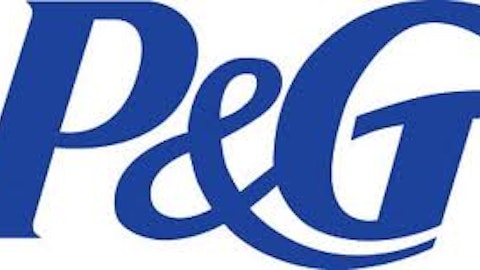Perhaps one of the greatest advantages that P&G can claim — and the true reason its share price didn’t collapse despite two profit warnings in 2012 — is the price inelasticity and intangible brand value associated with the dozens of personal-care products it sells. Household goods like detergent, toilet paper, and toothpaste aren’t exactly optional items. Regardless of the state of the economy, consumers are going to be purchasing these items without fail, which gives P&G incredible pricing power and incredible cash-flow predictability.
It also doesn’t hurt that many of its products are easily recognizable and practically a part of American culture.

Source: Scott Ehardt.
Tide and Crest, for example, are names that everyone from 8 to 80 years old would probably be able to associate as an American staple of detergents and toothpaste.
Putting all of these initiatives together, in P&G’s most recent quarter we saw marked improvement with diluted EPS growing 144% over the year-ago period and organic sales growth of 3%. Gross margin also jumped 80 basis points on a mixture of higher prices and lower manufacturing costs.
Buybacks, dividends, and a 123-year payout streak? Oh, my!
The Procter & Gamble Company (NYSE:PG)’s consistent success in the supermarket aisles has also translated into big wins for shareholders, and not just from a share-price appreciation perspective. The Procter & Gamble Company (NYSE:PG) has been a big proponent throughout the years of increasing shareholder value and returning cash to shareholders through share repurchases and increasing its annual dividend. Early last year, The Procter & Gamble Company (NYSE:PG) announced a $4 billion share-repurchase program and, in November, upped that to a range as high as $6 billion. While share repurchases don’t put money directly in shareholders’ pockets, they do make the company appear cheaper with fewer shares outstanding to compare total profits against.
This big allure of a consumer-products giant like The Procter & Gamble Company (NYSE:PG) is its dividend. The Procter & Gamble Company (NYSE:PG) has been paying a dividend for 123 consecutive years and holds the fifth-longest active annual dividend raising streak at a whopping 56 years! That’s right; P&G has raised its dividend every year since 1957.
Source: Nasdaq.com.
If you think about it, that’s even six more years than health-care conglomerate Johnson & Johnson (NYSE:JNJ) , which also sells personal-care products such as Band-Aids and shampoo, in addition to medical devices and brand-name drugs, and has a 50-year streak of increasing its dividends. J&J has been paying uninterrupted dividends since 1944, whereas P&G has been dishing out cash to shareholders without fail since 1891! Furthermore, P&G’s payout ratio is just 50%, leaving plenty of room for further dividend increases and creating a strong sense of payout sustainability.
Foolish roundup
For the conservative investor looking for a nice mix of dividend income and capital conservation, P&G is nearly the perfect stock consideration for your portfolio. P&G’s products have consistent demand and inelastic prices, which easily allow the company to keep up with inflationary input costs. It also is working on boosting sales in emerging markets while keeping a tight lid on domestic costs. With a multibillion-dollar share-repurchase program in place and a dividend yielding 2.8%, this is a dividend payer you can certainly count on.
The article 1 Great Dividend You Can Buy Right Now originally appeared on Fool.com.
Fool contributor Sean Williams has no material interest in any companies mentioned in this article. You can follow him on CAPS under the screen name TMFUltraLong, track every pick he makes under the screen name TrackUltraLong, and check him out on Twitter, where he goes by the handle @TMFUltraLong.The Motley Fool owns shares of Johnson & Johnson and recommends Johnson & Johnson, Kimberly-Clark, and Procter & Gamble.
Copyright © 1995 – 2013 The Motley Fool, LLC. All rights reserved. The Motley Fool has a disclosure policy.


